DOI:10.32604/cmc.2021.015826

| Computers, Materials & Continua DOI:10.32604/cmc.2021.015826 |  |
| Article |
RSS-Based Selective Clustering Technique Using Master Node for WSN
1GLA University, Mathura, India
2DPSM IIIT, Naya Raipur, India
3Compucom Institute of Technology & Management, Jaipur, India
4Lakshmi Narain College of Technology, Bhopal, India
5Vellore Institute of Technology, Vellore, 632014, India
6Industrial Engineering Department, College of Engineering, King Saud University, Riyadh, 11421, Saudi Arabia
7Raytheon Chair for Systems Engineering, Advanced Manufacturing Institute, King Saud University, Riyadh, 11421, Saudi Arabia
*Corresponding Author: Mustufa Haider Abidi. Email: mabidi@ksu.edu.sa
Received: 09 December 2020; Accepted: 17 February 2021
Abstract: Wireless sensor networks (WSN) are designed to monitor the physical properties of the target area. The received signal strength (RSS) plays a significant role in reducing sensor node power consumption during data transmission. Proper utilization of RSS values with clustering is required to harvest the energy of each network node to prolong the network life span. This paper introduces the RSS-based energy-efficient selective clustering technique using a master node (RESCM) to improve energy utilization using a master node. The master node positioned at the center of the network area and base station (BS) is placed outside the network area. During cluster head (CH) selection, the node with a high RSS value is more likely to become CH. The network is divided into segments according to the distance from the master node. All nodes near BS or master node transmit their data using direct transmission without the clustering process. The simulation results showed that the RESCM method improves the total network lifespan effectively.
Keywords: Wireless sensor network; received signal strength; clustering; base station; master node
A wireless sensor network (WSN) has many tiny nodes with sensing elements to observe the surrounding environment for various purposes, such as military, radiosensitive field, fire alarm, health monitoring, smart building, disaster management, and traffic monitoring [1,2]. A base station in the network is powered with unlimited power and processing capabilities and acts as a sink for all sensor nodes [3]. The sensor node is loaded with sensing elements, transmitters, limited processing capacity, and limited battery power [4]. The limited battery power becomes a bottleneck in the entire sensor network. These sensor nodes are deployed under such circumstances where the replacement of the battery is not easy, and almost not possible to change the power pack of a sensor node [5]. Thus, power management is a challenging issue in designing an extensive WSN [6,7].
Many hardware and software approaches have been proposed to solve the above energy conservation problems. Among these approaches, clustering is the most effective and applicable solution to reduce energy drainage for the sensor nodes [8–10]. A clustering process consists of two steps: network setup task and steady task. During the network setup process, all nodes select some cluster head (CH) among themselves based on predefined parameters and form groups of nodes [11–13]. During a steady process, all cluster member sensor nodes collect information by sensors and transmit this data to the respective CH using time division multiple access (TDMA) [14]. Fig. 1 shows a simple WSN clustering. CHs reduce duplicate information and minimize data size by aggregation and then transmit this information to the base station (BS).
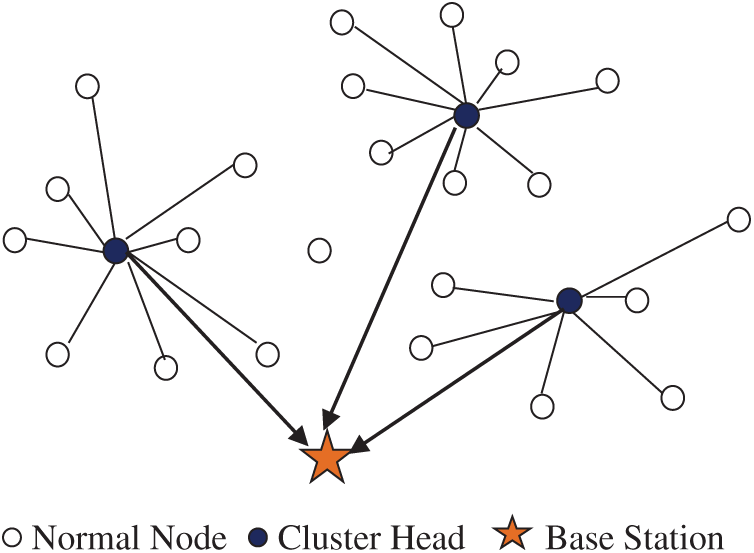
Figure 1: Architecture of WSN clustering
Low Energy Adaptive Clustering Hierarchy (LEACH) protocol is a milestone in the field of WSN clustering. It uses a distributed clustering approach [15,16]. LEACH protocol is designed to preserve the sensor node’s energy and improve network lifetime [17]. In the network setup for the first-round, all nodes have an equal probability to be selected as CH, and a random number is generated to select CH. If a random number for any node appears below the predefined threshold value T(n), then that node is selected as CH for this round. T(n) is calculated using Eq. (1). This CH selection is made for each round of data transmission [17].
where p is the probability of selecting a sensor node as CH, r is the current round, and G is a group of all sensor nodes participating node for CH.
The main contributions of this study focus on proper energy utilization among all sensor nodes using the received signal strength (RSS) values of each node. The proposed method organizes the network to use the advantage of distance of nodes from the BS and select CH by considering the RSS values. Besides, the study introduces a master node equipped with a rechargeable battery. The proposed method is compared with recent existing algorithms to verify its effectiveness. Thus, the main objective of this study is to reduce the energy consumption of all nodes and improve the throughput of WSN.
The remainder of the paper is organized as follows. Section 2 presents a detailed idea regarding WSN clustering and analyzes the existing studies in the clustering field by comparing some methods. Section 3 presents an overview of the network architecture used in this study. Section 4 explains the RSS-based clustering technique using the master node and the proposed algorithm. Results and comparison performed after implementing the proposed method are shown in Section 5. Section 6 concludes the overall study with its effectiveness, followed by future research indicators.
2 Literature Survey: A Brief Discussion
2.1 Basic Clustering Techniques
The underlying protocol used for clustering in WSN is LEACH [11]. This protocol changes CHs in each round with the same probability among all sensor nodes. It gives sensor nodes an equal chance to be CH and the same lifetime. It may select sensor nodes as CHs with low battery nodes so network lifetime down short duration [18].
Another clustering method, power-efficient gathering in sensor information systems (PEGASIS) [19], creates a chain from sensors to the BS and minimize clustering cost, but the chain creates overhead. The TEEN [20,21] protocol is used for re-active conditions. It may be used for applications based on events. However, this method may not perform well for simple WSN data collection.
Selective energy protocol (SEP) [22] works in a heterogeneous environment where some advanced nodes with more energy power than normal nodes. The SEP method improves the network lifespan; however, it may not be suitable for the homogenous environment.
A hybrid energy-efficient distributed clustering (HEED) protocol [23–25] is designed for a heterogeneous network. This method selects a CH based on the node’s residual energy; however, it cannot perform well for the non-uniform distribution of CHs and consumes many resources during network setup.
Some authors [26,27] introduced a new method for selecting CH by updating the threshold value. This helps to improve network lifespan and the number of packets transmitted to BS. However, this technique does not work within a heterogeneous sensor network environment. The authors in [28,29,29] used a technique to select a super CH based on fuzzy descriptors. This method improves the network stability period and lifespan, but the installation of mobile BS added extra cost.
Liang et al. [31] used harmony search (HS) to find an optimal number of CHs. This method eliminates the need to determine the number of clusters and removed the need to define many clusters initially.
Tab. 1 presents the well-known clustering techniques used in WSN with their advantages and disadvantages [30–38].

2.2 Research Gaps and Motivation
A sensor network is a sophisticated technology. It is beneficial to work in such an environment where human interaction is not easy to manage, such as a radioactive field, desert, forest, and military war field [34]. A sensor network is a primary component of the latest technology, internet of things (IoT) architecture [18,39]. The IoT is the future of machine to machine communication where machines can interact automatically without human interaction. Thus, it is necessary to develop a reliable and efficient WSN to empower IoT services effectively. In the last few decades, many studies have been conducted in the clustering field in WSNs. It becomes the most challenging task for researchers to manage proper energy utilization within the stipulated cost. Various methods performed well to increase network lifetime time as mentioned above; however, there is a scope to improve further using the latest techniques or new ideas. In line with the literature study, there is a gap to apply rechargeable sensor nodes within the existing studies. However, the installation of all rechargeable sensor nodes may increase the implementation cost. Thus, there must be a balance between implementation cost and quantity of rechargeable nodes without compromising the network lifetime.
This section introduces the RSS-based energy-efficient selective clustering using a master node (RESCM) scheme. It organizes sensor networks in different ways to utilize network energy properly among all nodes [40]. According to this network, the organization of the BS is placed outside the network area. The BS has an unlimited energy supply with huge memory capacity and processing capability. A master node is introduced within the network as a special node. It has more memory and processing capability compared to sensor nodes. This master node installs with a rechargeable battery supply. The network consists of homogeneous sensor nodes with different RSS values. Fig. 2 shows the detailed network architecture. The green-colored segments in the network indicate the area near BS or master node. All nodes within this segment transmit the sensed data directly without the need for CH. The high RSS value nodes are shown by the red color in the network diagram.
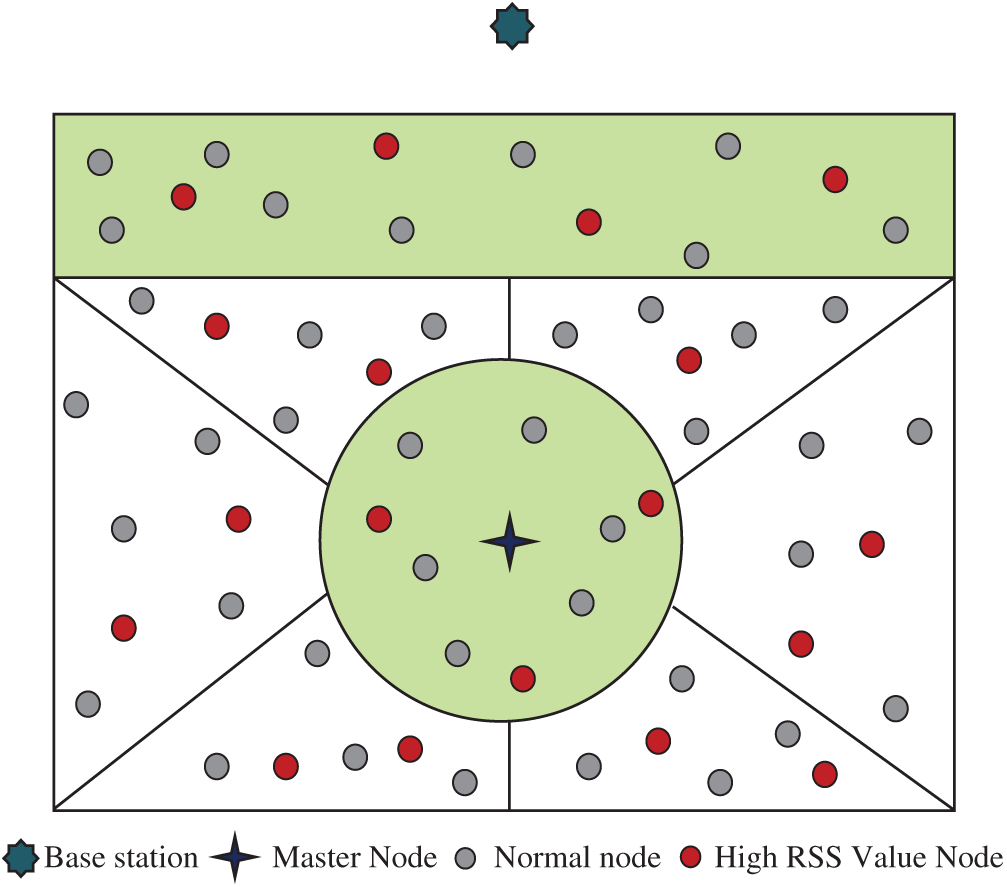
Figure 2: RESCM scheme network architecture
The energy used by any sensor node to transmit sensed data Etx can be expressed as the following equation [34].
where k is the number of bits transmitted, d is the distance of a node from the receiver.
The power used to receive data
4 RESCM Protocol: Proposed Methodology
This section presents details of the proposed RESCM, an RSS-based clustering protocol. Each sensor node inside the network field transmits its sensed data to BS, then the BS process incoming data as required. For each round, CH combines the sensed data and transmits data of all cluster member nodes and transmits this combined information within a single packet to the BS. Thus, a master node is deployed at the midpoint of the sensor network to minimize the transmission power of long-distance nodes. The master node collects packets from all the nodes, and CH is placed near it, and then sends the combined data packet to the BS. This technique improves the network’s overall lifetime and total packet transmission within the network at the cost of an extra master node. This master node’s battery may be recharged on-demand. The cost of recharging the master node’s battery will always be less compared to a new sensor node. Thus, this technique reduces the total network cost and increases the throughput.
4.1 Network Establishment Phase
All sensor nodes in the WSN have equal battery power during the network initialization in a homogenous environment. The nodes are placed in a random manner inside the network field. BS sends ping packets to all the sensor nodes. All sensor nodes reply to their physical location to the BS. Then, BS stores all information in its memory. After that, BS derives the distance of all sensor nodes to the BS, and then the master node stores this information with the respective node ID.
It is necessary to set up the network to improve performance. Thus, the RESCM method partitions the network area into virtual segments according to node distance from BS or master node. All sensor nodes present within the first segment direct link to transmit data to BS because of the short transmission range. Similarly, all nodes near the master nodes use a direct link to transmit data as short-range transmission. Then, master nodes aggregate data and forward it to the BS. These two segments are known as direct transmission segments, and there is no need for a clustering process. All remaining nodes are placed far away from the BS, or the master node is partitioned into two segments. These segments are known as clustering segments. In all nodes, which are present in the clustering segment, and data transmission occurs after the clustering process by CH.
The RESCM method first partitions the overall network into different segments; it then selects CH for each segment independently. CH is selected according to the node RSS values, a node with higher RSS value is more likely to be selected as CH for the current round. As network starts to transmit sensed data to BS, for the first-round all nodes have the same energy levels and equal probability of being a CH. CH is selected by comparing the weight calculated using the remaining energy and RSS values. To balance the energy consumption, the same node cannot be selected as CH for the next round like LEACH protocol. The probability of selecting CH increases for each upcoming round to balance the number of CHs. A node is selected as CH if its weight is less than all other nodes. The value of the threshold parameter T(s) and weight (w) can be calculated as follows:

Figure 3: Flowchart of RESCM method
Here, p represents the required percentage of CH, and r is the current round, G is the set of all nodes participating for CH within the current ‘r’ round. Eq. (7) uses RSS values as the received signal strength of each node. α and β are weight parameters such that the sum of α and β is always 1, and they may assign any value as per the requirement. These equations assign both T(s) and RSS with equal weight; hence, α = 0.5 and β = 0.5. This process is performed by each segment for CH selection. Once the CH selection process is completed, the CH broadcasts the hello packet to all its neighbor nodes. Every node receiving the hello packet responds with acknowledgment, and the node becomes a member of its nearest CH. Thus, the RSS value helps select CH with more signal strength and energy consumption decreases. If the selected CH has high signal strength, it can transmit signals through long-distance using less power consumption, and if the selected CH has low signal strength, then extra energy is required to transmit data.
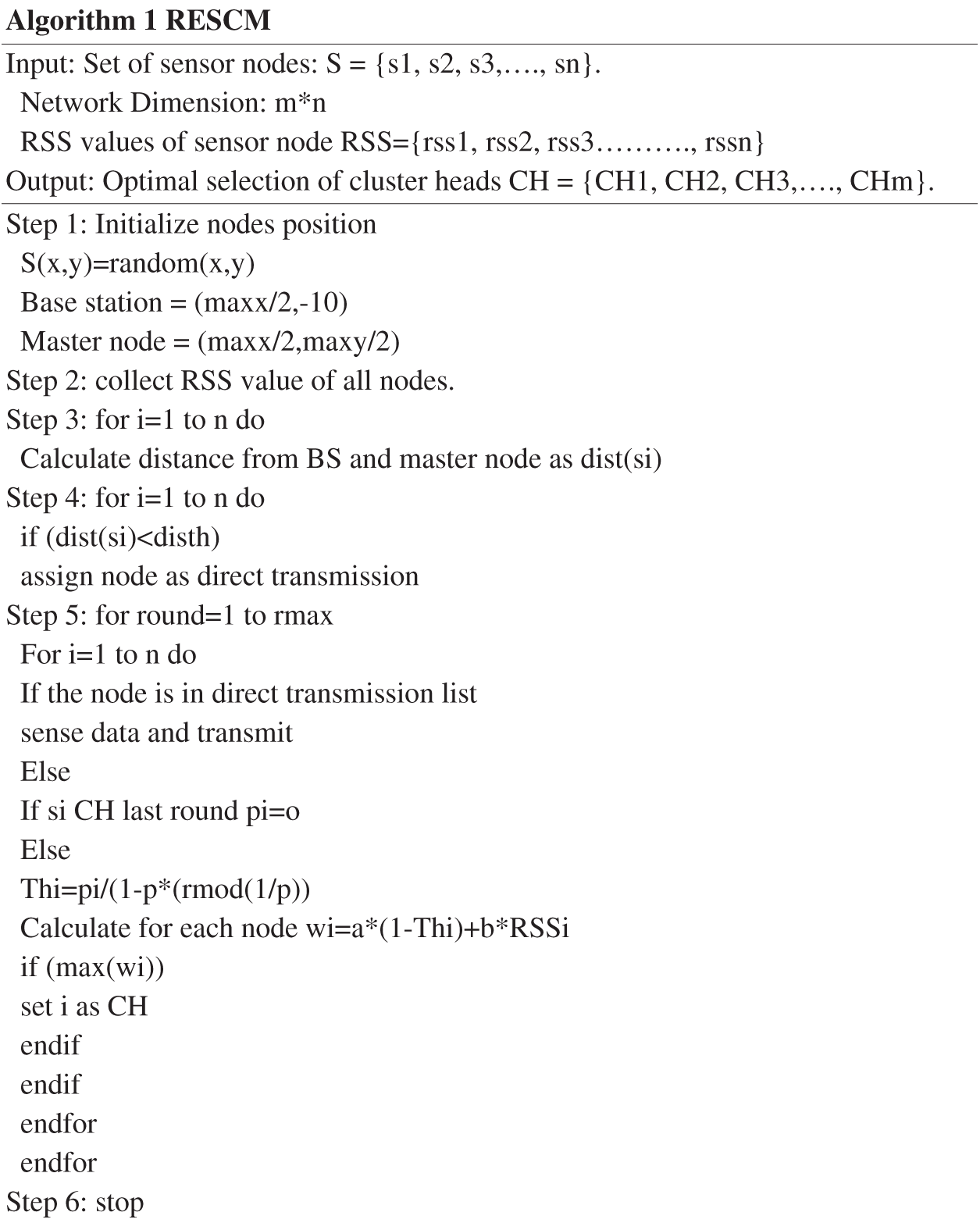
Figure 4: Pseudocode of the RESCM for CH selection using a master node algorithm
In this phase, all sensor nodes sense data according to the installed physical sensor for the current round. All nodes near BS or master node transmit data directly to the BS or master node. All member nodes transmit data to their CH. The CH aggregates the data packet by inserting its sensed data with all member nodes and then transmits it to the master node. The master node receives data from all CH and creates a common packet by combining all data and then sends it to the BS.
Figs. 3 and 4 show the detailed flowchart and algorithm, respectively.
The RESCM method worked on RSS values by limited clustering. The RESCM method performance is compared with benchmark techniques LEACH [8], SEP [22], LEACH-C [40], and LEACH-VA [37] protocol for WSN. This study uses MATLAB 2015a for simulation analysis. The simulation was performed with 100 × 100 m network area and randomly placed 100 sensor nodes. A master node is placed at the center of the network to cover most of the sensor nodes. The BS is installed on one side of the network field, and both master node and BS cannot change their position after they are placed. The master node’s battery is equipped with a rechargeable battery, and it can be recharged whenever the charge is less. The sensing information packets transmitted in the network are considered with a size of 4000 bits, including all information and routing overhead. Tab. 2 presents all parameters used during the simulation.

This study is evaluated based on the following performance indicators.
Network Lifespan: A network lifetime is the duration from sending the first sensed data to the last packet transmitted to the BS. The sensing information can be transmitted until at least a single node is alive. The network lifespan is the duration of all sensor nodes being alive. If the first node dies, the network becomes unstable.
Throughput: Throughput is a ratio between the total packets received by a BS to complete packets transmitted by all sensor nodes for each round of data transmission.
Residual Energy: The network residual energy can be measured as an average of residual energy of all live sensor nodes within the network. As the network transmits data to the BS continuously, the network residual energy becomes low, and it reaches zero as all sensor nodes are dead.
Network Lifespan: Fig. 5 shows the network lifespan of the RESCM method. The nodes have 0.5 J power and become dead after the entire energy is exhausted after transmission. The observation clarifies that the RESCM method performs well compared to LEACH, SEP, {LEACH-C}, and LEACH-VA methods because of the balanced energy consumption and distribution to all nodes. In the LEACH method, the energy consumption among nodes does not distribute correctly; thus, very quickly nodes start to die, and the network becomes unstable. The RESCM method uses a direct transmission link for nodes near the BS and master nodes. Thus, the energy of these nodes is consumed less compared to all other cluster member nodes. Besides, the RSS-based CH selection reduces high power consumption to transmit long-distance signals over traditional methods. The RESCM method stability period is less compared to that of LEACH-C and LEACH-VA, but when the network works for longer durations, RESCM performs well to improve network life span.
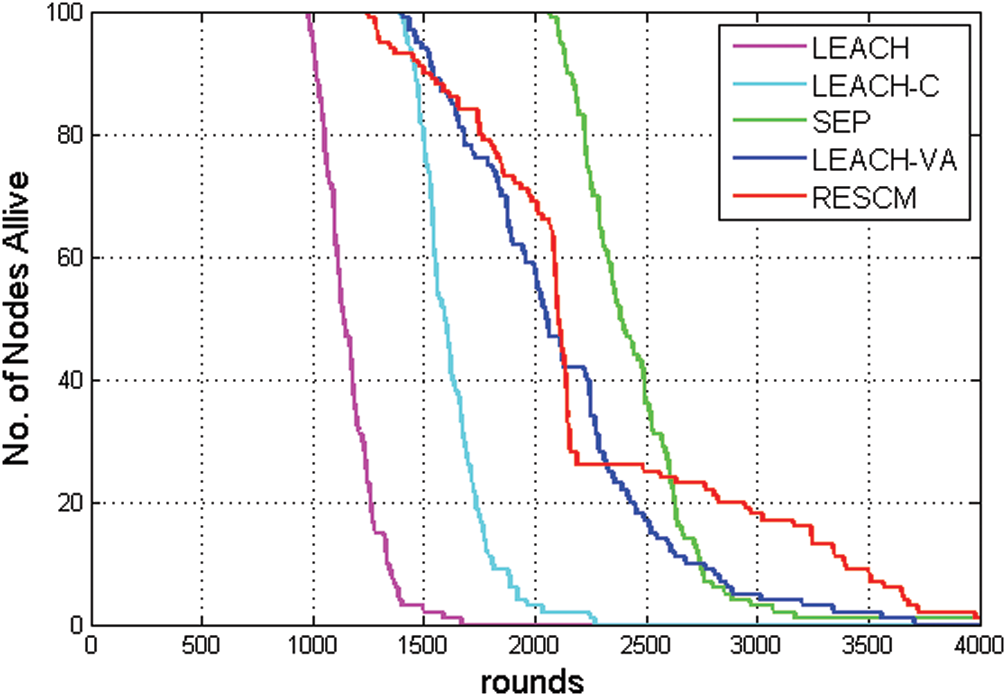
Figure 5: Network lifespan comparison of RESCM with existing methods
Throughput: Fig. 6 shows the packets transmitted to the BS during network lifespan using RESCM to LEACH, SEP, LEACH-C, LEACH-VA methods. The figure demonstrates the RESCM method’s effectiveness over the LEACH protocol. The master node used only transmission data of all CH and direct transmission nodes aggregate data; it did not sense and transmit their data.
The total packets transmitted by the RESCM method are about two times more than the LEACH-VA protocol. The nodes near to master node and BS send their data directly without taking part in the clustering process. The energy required for overhead was saved in the RESCM method. Thus, these nodes transmit data for more rounds without dying early.
Residual Energy: This study assumes that 100 sensor nodes are randomly deployed within the network; each node is equipped with 0.5 J energy at the time of initialization; thus, the network initially has 50 J energy. Fig. 7 shows the network’s total average energy. After each round, this comparison clarifies that the RESCM method performed better to minimize energy consumption. The master node placed at the network center helped the CHs transmit data in a short distance compared to the LEACH-VA protocol. Thus, the network average residual is energy-optimized.
Tab. 3 shows a detailed result comparison of the RESCM method with LEACH and SEP protocol. The simulation results showed that LEACH protocol becomes unstable after 978 rounds, SEP becomes unstable after 2067 rounds, LEACH-VA maintains stability till 1401, but RESCM is stable up to 1278 rounds. The network lifetime for LEACH is about 1585 rounds, SEP lifespan about 3167 round, LEACH-VA network worked up to 3558 rounds; however, RESCM reached 4000 rounds by proper energy distribution. Thus, the RESCM method has an improved network lifespan by 26% compared to SEP and 13% compared to LEACH-VA.

Figure 6: Throughput comparison of RESCM with existing methods
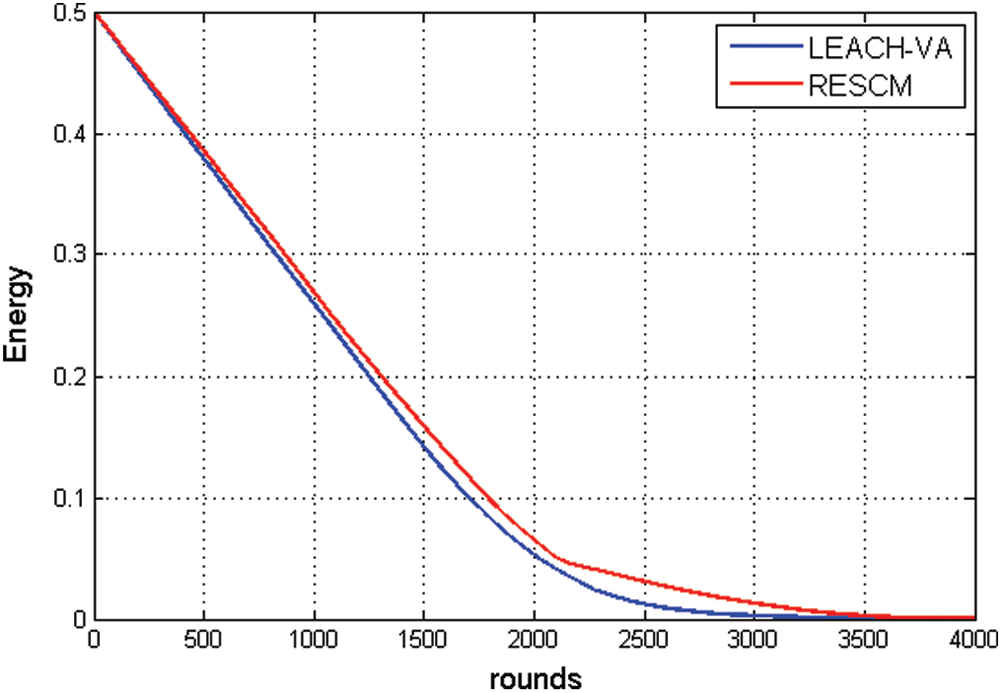
Figure 7: Network residual energy comparison of the RESCM with the existing methods

WSNs are a backbone for the recently trending topic: the IoT. All research has been conducted in the field of WSN using LEACH protocol as a key indicator. The proposed RESCM method overcomes the conventional LEACH protocol limitations. It uses the master node for multi-hop transmission equipped with a rechargeable battery to overcome battery replacement problems. This study splits the network into logical segments. Each segment communicates with a different transmission level. Two segments are predefined for direct transmission, and the rest of the segments select CH using the RSS-based clustering technique with multi-hop transmission. CH selection within a segment is independent of other segments, leading to the selection of an optimum number of CHs within the network. This study compares the RESCM method’s performance with LEACH based on three parameters: network lifetime, network residual energy, and total packet transmission. The simulation results showed that the RSS-based clustering technique using a master node with segmented network improves network residual energy to prolong network lifespan. The network stability period improves compared to LEACH and SEP methods. Besides, the RESCM method has an improved network lifespan by 26% compared to SEP and 13% compared to LEACH-VA.
Acknowledgement: The authors are grateful to the Raytheon Chair for Systems Engineering for funding.
Funding Statement: The authors are grateful to the Raytheon Chair for Systems Engineering for funding.
Conflicts of Interest: The authors declare that they have no conflicts of interest to report regarding the present study.
1. O. O. Ogundile and A. S. Alfa, “A survey on an energy-efficient and energy-balanced routing protocol for wireless sensor networks,” Sensors, vol. 17, no. 5, pp. 1084–1091, 2017. [Google Scholar]
2. C. T. Kone, A. Hafid and M. Boushaba, “Performance management of IEEE 802.15.4 wireless sensor network for precision agriculture,” IEEE Sensors Journal, vol. 15, no. 10, pp. 5734–5747, 2015. [Google Scholar]
3. S. Kurt, H. U. Yildiz, M. Yigit, B. Tavli and V. C. Gungor, “Packet size optimization in wireless sensor networks for smart grid applications,” IEEE Transactions on Industrial Electronics, vol. 64, no. 3, pp. 2392–2401, 2017. [Google Scholar]
4. M. Hammoudeh, F. Al-Fayez, H. Lloyd, R. Newman, B. Adebisi et al., “A wireless sensor network border monitoring system: Deployment issues and routing protocols,” IEEE Sensors Journal, vol. 17, no. 8, pp. 2572–2582, 2017. [Google Scholar]
5. M. Kaddi, K. Benahmed and M. Omari, “An energy-efficient protocol using an objective function & random search with jumps for WSN,” Computers, Materials & Continua, vol. 58, no. 3, pp. 603–624, 2019. [Google Scholar]
6. S. Bhagyashree, S. Prashanthi and K. M. Anandkumar, “Enhancing network lifetime in precision agriculture using Apteen protocol,” in Technological Innovation in ICT for Agriculture and Rural Development (TIAR) 2015 IEEE, Chennai, India, pp. 44–48, 2015. [Google Scholar]
7. M. I. Chidean, E. Morgado, E. Del Arco, J. Ramiro-Bargueno and A. J. Caamaño, “Scalable data-coupled clustering for large scale WSN,” IEEE Transactions on Wireless Communications, vol. 14, no. 9, pp. 4681–4694, 2015. [Google Scholar]
8. W. R. Heinzelman, A. Chandrakasan and H. Balakrishnan, “Energy-efficient communication protocol for wireless microsensor networks,” in Proc. of the 33rd Annual Hawaii Int. Conf. on System Sciences, IEEE Computer Society, Maui, HI, USA, pp. 10, 2000. [Google Scholar]
9. X. Tang, M. Zhang, P. Yu, W. Liu, N. Cao et al., “A nonuniform clustering routing algorithm based on an improved k-means algorithm,” Computers, Materials & Continua, vol. 64, no. 3, pp. 1725–1739, 2020. [Google Scholar]
10. H. Zhao and L. Guo, “Energy saving of wireless sensor network based on topology control algorithm,” IEEE Access, vol. 7, pp. 85525–85535, 2019. [Google Scholar]
11. K. Kalaivanan and V. Bhanumathi, “Reliable location aware and cluster-tap root based data collection protocol for large scale wireless sensor networks,” Journal of Network and Computer Applications, vol. 118, pp. 83–101, 2018. [Google Scholar]
12. G. S. Arumugam, “EE-LEACH: Development of energy-efficient LEACH Protocol for data gathering in WSN,” EURASIP Journal on Wireless Communications and Networking, vol. 1, no. 1, pp. 1–9, 2015. [Google Scholar]
13. A. Somani and P. P. Bhattacharya, “Analyzing the network lifetime of heterogeneous LEACH and TEEN in three dimensional wireless sensor networks,” in IEEE Int. Conf. on Power Electronics Intelligent Control and Energy Systems, Delhi, India, pp. 1–4, 2016. [Google Scholar]
14. G. Ran, H. Zhang and S. Gong, “Improving on LEACH protocol of wireless sensor networks using fuzzy logic,” Journal of Information & Computational Science, vol. 7, no. 3, pp. 767–775, 2010. [Google Scholar]
15. X. Wang, “A kind of novel VPF-based energy-balanced routing strategy for wireless mesh network,” International Journal of Communication Systems, vol. 30, no. 6, pp. 1–15, 2017. [Google Scholar]
16. S. Singh, P. Kumar and J. Singh, “A survey on successors of LEACH protocol,” IEEE Access, vol. 5, pp. 4298–4328, 2017. [Google Scholar]
17. M. Z. Siam, M. Krunz and O. Younis, “Energy-efficient clustering/routing for cooperative mimo operation in sensor networks,” in INFOCOM, 2009 IEEE, Rio de Janeiro, Brazil, pp. 621–629, 2009. [Google Scholar]
18. G. Ran, H. Zhang and S. Gong, “Improving on LEACH protocol of wireless sensor networks using fuzzy logic,” Journal of Information & Computational Science, vol. 7, no. 3, pp. 767–775, 2010. [Google Scholar]
19. M. Zanjireh and H. Larijani, “A survey on centralised and distributed clustering routing algorithms for WSNs,” in IEEE 81st Vehicular Technology Conf. (VTC SpringGlasgow, UK, pp. 1–6, 2015. [Google Scholar]
20. J. Wang, Y. Gao, X. Yin, F. Li and H. J. Kim, “An enhanced PEGASIS algorithm with mobile sink support for wireless sensor networks,” Wireless Communications and Mobile Computing, vol. 2018, pp. 9, 2018. [Google Scholar]
21. A. Manjeshwar and D. P. Agrawal, “TEEN: A routing protocol for enhanced efficiency in wireless sensor networks,” in 15th Int. Sym. on Parallel and Distributed Processing, San Francisco, USA, pp. 2009–2015, 2001. [Google Scholar]
22. Y. Ge, S. Wang and J. Ma, “Optimization on TEEN routing protocol in cognitive wireless sensor network,” Journal on Wireless Communications and Networking, vol. 2018, no. 1, pp. 1–9, 2018. [Google Scholar]
23. G. Smaragdakis, I. Matta and A. Bestavros, “SEP: A stable election protocol for clustered heterogeneous wireless sensor networks,” in Second Int. Workshop on Sensor and Actor Network Protocols and Applications, Boston, Massachusetts, USA, 2004. [Google Scholar]
24. F. A. Khan, M. Khan, M. Asif, A. Khalid and I. U. Haq, “Hybrid and multi-hop advanced zonal-stable election protocol for wireless sensor networks,” IEEE Access, vol. 7, pp. 25334–25346, 2019. [Google Scholar]
25. O. Younis and S. Fahmy, “HEED: A hybrid, energy-efficient, distributed clustering approach for ad hoc sensor networks,” IEEE Transactions on Mobile Computing, vol. 3, no. 4, pp. 366–379, 2004. [Google Scholar]
26. Z. Ullah, L. Mostarda, R. Gagliardi, D. Cacciagrano and F. Corradini, “A comparison of HEED based clustering algorithms-introducing ER-HEED,” in Proc. IEEE AINA, Crans-Montana, Switzerland, pp. 339–345, 2016. [Google Scholar]
27. M. Elshrkawey, S. M. Elsherif and M. E. Wahed, “An enhancement approach for reducing the energy consumption in wireless sensor networks,” Journal of King Saud University-Computer and Information Sciences, vol. 30, no. 2, pp. 259–267, 2017. [Google Scholar]
28. M. Abo-Zahhad, S. M. Ahmed, N. Sabor and S. Sasaki, “Mobile sink-based adaptive immune energy-efficient clustering protocol for improving the lifetime and stability period of wireless sensor networks,” IEEE Sensors, vol. 15, no. 8, pp. 4576–4586, 2015. [Google Scholar]
29. P. Nayak and A. Devulapalli, “A fuzzy logic-based clustering algorithm for WSN to extend the network lifetime,” IEEE Sensors Journal, vol. 16, no. 1, pp. 137–144, 2016. [Google Scholar]
30. P. Neamatollahi, M. Naghibzadeh and S. Abrishami, “Fuzzy-based clustering-task scheduling for lifetime enhancement in wireless sensor networks,” IEEE Sensors Journal, vol. 17, no. 20, pp. 6837–6844, 2017. [Google Scholar]
31. H. Liang, S. Yang, L. Li and J. Gao, “Research on routing optimization of WSNs based on improved LEACH protocol,” Journal on Wireless Communications and Networking, vol. 194, pp. 1–12, 2019. [Google Scholar]
32. O. M. Alia, “A dynamic harmony search-based fuzzy clustering protocol for energy-efficient wireless sensor networks,” Annals of Telecommunications, vol. 73, no. 5, pp. 353–365, 2018. [Google Scholar]
33. P. Nayak and B. Vathasavai, “Energy efficient clustering algorithm for multi-hop wireless sensor network using type-2 fuzzy logic,” IEEE Sensors Journal, vol. 17, no. 14, pp. 4492–4499, 2017. [Google Scholar]
34. D. G. Zhang, T. Zhang, J. Zhang, Y. Dong and X. D. Zhang, “A kind of effective data aggregating method based on compressive sensing for wireless sensor network,” Journal on Wireless Communications and Networking, vol. 159, pp. 1–5, 2018. [Google Scholar]
35. W. B. Heinzelman, A. P. Chandrakasan and H. Balakrishnan, “Application specific protocol architecture for wireless micro-sensor networks,” Wireless Communications, IEEE Transactions, vol. 1, no. 4, pp. 660–670, 2002. [Google Scholar]
36. Y. Yu, B. Xue, Z. Chen and Z. Qian, “Cluster tree topology construction method based on PSO algorithm to prolong the lifetime of ZigBee wireless sensor networks,” Journal on Wireless Communications and Networking, vol. 199, no. 1, pp. 1–13, 2019. [Google Scholar]
37. P. Feng, D. Qin, P. Ji, M. Zhao, R. Guo et al., “Improved energy-balanced algorithm for underwater wireless sensor network based on depth threshold and energy level partition,” Journal on Wireless Communications and Networking, vol. 228, no. 1, pp. 1–5, 2019. [Google Scholar]
38. H. Liang, S. Yang, L. Li and J. Gao, “Research on routing optimization of WSNs based on improved LEACH protocol,” Journal on Wireless Communications and Networking, vol. 194, pp. 1–2, 2019. [Google Scholar]
39. P. Wan, Y. Cheng, B. Wu and G. Wang, “An algorithm to optimize deployment of charging base stations for WRSN,” Journal on Wireless Communications and Networking, vol. 163, pp. 1–9, 2019. [Google Scholar]
40. M. Kaddi, A. Banana and M. Omari, “ECO-BAT: A new routing protocol for energy consumption optimization based on bat algorithm in WSN,” Computers, Materials & Continua, vol. 66, no. 2, pp. 1497–1510, 2021. [Google Scholar]
 | This work is licensed under a Creative Commons Attribution 4.0 International License, which permits unrestricted use, distribution, and reproduction in any medium, provided the original work is properly cited. |